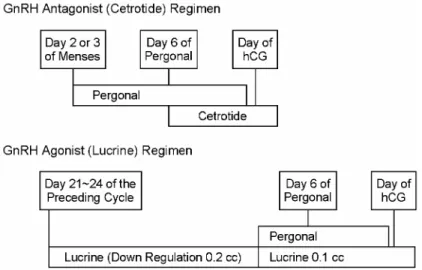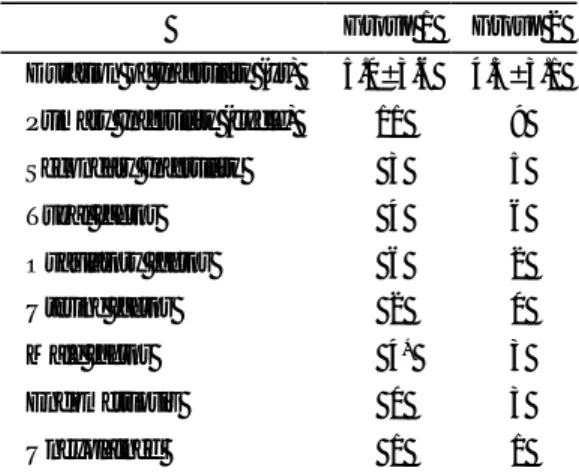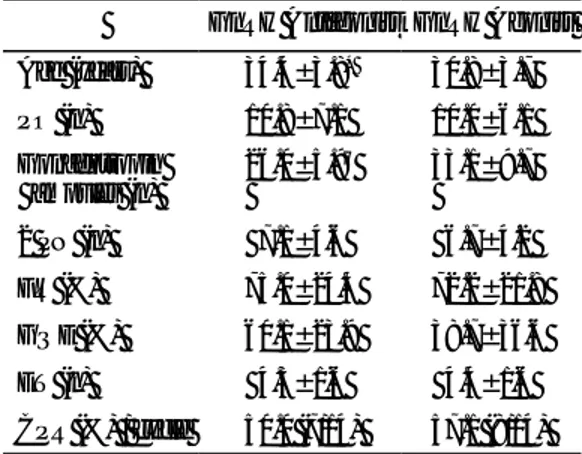大 韓 不 妊 學 會 誌 : 第 28 卷 第 4 號 2001 Kor. J. Fertil. Steril., Vol. 28, No. 4, 2001, 12
GnRH Antagonist (Cetrotide) Short Protocol의 임상적 유용성에 관한 연구
인제대학교 의과대학 일산백병원 산부인과학교실
김 문 영・정 병 준
A Study for GnRH Antagonist (Cetrotide) Short Protocol in Controlled Ovarian Hyperstimulation
Moon Young Kim, Byeong Jun Jung
Department of Obstetrics and Gynecology, College of Medicine, Inje University, Ilsan Paik Hospital, Kyunggi, Korea
Objective : The aim of this study was to evaluate the outcome the GnRH antagonist (Cetrotide) short protocol in controlled ovarian hyperstimulation comparing with GnRH agonist long protocol.
Materials and Method: From July 2000 to November 2001, 26 patients, 28 cycles were performed in controlled ovarian hyperstimulation by GnRH antagonist and GnRH agonist. GnRH antagonist (Cetrotide) was administered in 12 patients (14 cycles, Group 1) and GnRH agonist (Lucrin, Sub Q, Group 2) in 14 patients (14 cycles). Ovulation induction was performed by hMG (Pergonal) in group 1, and by Combo (Metrodine HP + Pergonal) in group 2. We compared the fertilization rate, good quality embryo, and clinical pregnancy rate between the two groups. Student-t test and Chi-square were used to determine statistical significance. Statistical significance was defined as p<0.05.
Results: Ovarian hyperstimulation syndrome did not occurred in which estradiol (E
2) level was 3874
±809 pg/ml and the numb er of retrieved oocytes was 18.4±2.4. The number of used gonadotropin ampules was significantly decreased in Group 1 (26.0 vs. 33.1, p<0.04). There were no significant difference in the number of preovulatory oocyte (10.6±6.9 vs. 10.0±6.1), fertilization rate (74.8±23.4 vs. 72.2±21.8), good quality embryo (58.7±23.6 vs. 38.7±36.6), and embryo transfer (4.3±1.6 vs. 4.4
±1.6). Although the age of the group 1 was older than the group 2 (34.4 vs. 30.8), there was no significant difference in clinical pregnancy rate (50.0% vs. 57.1%).
Conclusions: We suggest that GnRH antagonist was a safe, effective, and alternative method in the controlled ovarian hyperstimulation, especially in PCOD patients who will be develop the ovarian hyperstimulation syndrome.
Key Words: GnRH antagonist, Ovarian hyperstimulation syndrome
체외수정시술 등의 보조생식술에 있어서 난소의 과배란유도시 일반적으로 사용되는 GnRH agonist는 장기간 투여하여 뇌하수체에 존재하는 GnRH 수용
체에 결합하여 GnRH 수용체에 대한 down-regulation 과 gonadotrophic cell의 탈감작에 의하여 난소에서의 호르몬 생성을 억제하는 것으로 과배란유도가 상대 주관책임자: 정병준, 우) 402-859 인천광역시 남구 주안 4동 1534-4, 서울여성병원 불임클리닉
Tel: (032) 230-3630, Fax: (032) 247-2001, e-mail: byeongjj@orgio.net
적으로 유리해지고 난자 채취율 및 임신율이 증가 하였으나, 뇌하수체 억제에 필요한 투여기간이 2~
3주 필요하고, estradiol의 혈중 농도가 감소함에 따 라 안면홍조, 질건조감 등의 소퇴성 증상이 나타난 다.1 반대로 GnRH antagonist는 뇌하수체의 GnRH 수 용체에 직접 작용하여 GnRH 작용을 완전히 차단한 다. 따라서 GnRH antagonist는 agonist 사용시 초기에 LH, FSH의 분비가 급격히 증가하면서 나타나는 초 기 flare-up 효과 없이 단시간에 GnRH 억제 효과를 나타낸다.
이에 Albano 등,2 Olivennes 등,3 Borm 등4은 무작 위 연구를 통하여 체외수정시술에서 GnRH antago- nist와 GnRH agonist의 임신율을 비교하였을 때, 치 료기간이 짧아지고, 사용한 gonadotropin의 양이 유의 하게 감소되었으나, 임신율이 GnRH antagonist군에 서 유의하게 감소하였다고 보고하였다. 또한 Hernan- dez5는 GnRH antagonist로 과배란을 유도한 군에서 과배란유도증후군이 50% 이하로 감소하였다고 보고 하였다.
이에 인제대학교 일산백병원 산부인과 불임클리 닉에서는 GnRH antagonist 단기요법을 이용한 체외 수정시술이 기존의 GnRH agonist 장기요법과 수정 률과 좋은 질의 배아발달률 및 임신율에 차이가 있 나를 알아보기 위해서 본 연구를 시행하였고, 또한 배란장애를 갖는 다낭성 난포종 환자에서 GnRH antagonist를 이용한 과배란유도가 과배란유도증후군
을 예방할 수 있는지를 알기 위해 본 연구를 시행하 였다.
연구 대상 및 방법
2000년 6월부터 2001년 11월까지 불임을 주소로 본원 산부인과 불임클리닉에 내원하여 체외수정시 술을 받은 26명의 환자를 대상으로 하였다. 12명 (14 주기)는 GnRH antagonist (Cetrotide 0.25 mg, ASTA Medica AG)으로 과배란유도를 시행하였고, 14명 (14 주기)은 GnRH agonist (Lucrin subQ, ABBOT) 장기요 법을 이용하여 과배란유도를 시행하였다.
GnRH antagonist 요법은 월경주기 제2~3일부터 매일 hMG (Pergonal) 3 ampules 씩 투여하고, 난포의 크기에 따라서 월경주기 6~7일부터 매일 Cetrotide 0.25 mg 씩 피하주사 하였다. 이때부터 난포의 성장 에 따라 hMG 용량을 조절하였고, 초음파상 우성난 포의 직경이 18 mm 이상이면 hCG (Profaci, Serono) 10,000 IU를 투여하였다. GnRH agonist 장기요법은 월경주기 21일부터 Lucrin (SubQ) 0.2 cc (1 mg)를 피 하주사 하고, 다음 월경주기 2일부터 hMG 또는 M e- trodin HP를 투여하였다. 같은 방법으로 gonadotrpin 용량을 조절하고 hCG를 투여하였다 (Figure 1). hCG 투여 후 36시간 후에 난포를 채취하였으며 72시간 후 배아이식을 시행하였다. 남성불임이 원인인 환 자에서는 세포질내 정자주입 (Intracytoplsmic sperm
Figure 1. Schematic presentation of the treatment regimens.
injection, ICSI)을 시행하였다. 황체기 보완을 위해 황 체호르몬 (Progest, 삼일제약)을 1.5~2 cc (75~100 mg) 씩 배아이식 후부터 임신 8주까지 투여하였다.
두 군에서 사용한 gonadotropin의 용량, 채취한 난 포 수, 수정률, Good quality embryo 수, 임상적 임신 율을 비교하였다. 또한 배란장애를 갖는 환자 중, 초음파상 다낭성 난포의 형태를 보이며, hCG 투여 한 날의 혈중 E2 농도가 3,000 pg/ml 이상이면서, 채 취한 난포 수가 15개 이상인 환자에서는 월경주기 제3일, 6일, hCG 투여일에 각각 LH, FSH, E2의 양상 및 과배란유도증후군의 발생 유무를 알아보았다.
통계학적 분석은 student t-test 및 Chi-square 검사 를 이용하였고, p<0.05인 경우 통계학적 유의성이 있 는 것으로 판정하였다.
결 과
2000년 6월부터 2001년 11월까지 불임클리닉에 내 원하여 체외수정시술을 받은 환자 중 GnRH antago- nist short protocol을 이용한 과배란유도주기와 GnRH agonist long protocol을 이용한 주기를 대상으로 하였 다. Group 1은 GnRH antagonist를 이용한 12명 (14주 기)의 환자가 과배란유도를 시행하였고, Group 2는 GnRH agonist를 이용한 14명 (14주기)을 대상으로 하였다.
불임의 원인으로는 중복된 경우도 각각의 불임의
원인으로 보았을 때, Group 1은 난관요인 4명, 배란 장애 6명, 남성불임 4명, 자궁요인 2명, 원인불명 1 명이었으며, Group 2는 난관요인 6명, 배란장애 2명, 남성불임 3명, 자궁내막증 3명, 원인불명 1명이었다 (Table 1). 남성불임 환자 7명 중 Group 1에서는 4명 모두, Group 2에서는 3명 중 2명에서 세포질내 정자 주입을 시행하였다. 원발성불임과 속발성불임의 빈 도 및 불임기간도 양군간에 유의한 차이가 없었다 (Table 1).
Group 1에서 배란장애가 원인인 환자 중 초음파 상 다낭성 난포모양을 보이는 경우에 호르몬 양상은 월경주기 3일 혈중 LH (mIU/ml) 5.5±1.5이고, FSH (mIU/ml) 4.0±1.0이며, E2 (pg/ml) 40.2±7.6이었다. Gn RH antagonist를 투여하기 직전인, 월경주기 6~7일 에 시행한 혈중 LH, E2 농도는 각각 2.1±1.3, 650±
315이었고, hCG 투여날에 시행한 혈중 LH, FSH, E2
농도는 각각 3.3±2.7, 6.5±0.7, 3874±809 (3078~
4923)이었다. 이후 채취한 난포의 수는 18.4±2.4개 였다 (Table 2). 이들 환자 중에서 경증이상의 과배 란유도증후군이 한 명에서도 발생하지 않았다.
Group 1의 평균 연령은 34.4세로 Group 2의 30.8 세에 비해 평균 연령이 유의하게 높았다. 그러나 이 에 반해 채취 전 난포 수 (10.6±6.9 vs. 10.0±6.1), 수 정률 (74.8±23.4 vs. 72.2±21.8)은 두 군에서 유의한 차이가 없었다. 8세포기 중 배아의 질이 양질인 Gr- ade I, II를 채취한 배란 전 난포 수의 백분율을 표기 한 Good quality embryo (GQE)는 통계학적 유의성은 없으나 Group 1에서 Group 2의 38.7±36.6%에 비해 58.7±23.6%로 높게 나타났다. 주기당 임신율은 Gr- oup 1은 50.0%, Group 2는 57.1%로 두 군에 차이가 없었다. 다태임신의 경우는 Group에서만 2명으로 나 타났다. 단지 Group 1에서 무정자증으로 부고환에서 정자를 취하여 (PESA) 세포질내 정자주입술을 시행
Table 1. Comparison of Clinical characteristics
Group 1 Group 2 Duration of Infertility (yr) 5.0±3.6 4.3±3.1 Primary Infertility (cycle) 11 9 Secondary Infertility 3 5
Tubal factor 4 6
Ovaulatory factor 6 2 Uterine factor 2 0
Male factor 4* 3
Endometriosis 0 3
Unexplained 1 1
* : Included obstructive azoospermia and severe oligo- azoospermia
Table 2. Serum hormone concentration in polycystic
ovary pattern of GnRH antagonist groupLH (mIU/ml)
FSH (mIU/ml)
E2
(pg/ml) MCD #3 5.5±1.5 4.0±1.0 40.2±7.6 MCD #6 2.1±1.3 650±315 Day of hCG 3.3±2.7 6.5±0.7 3874±809
한 1명의 환자에서만 임신 9주에 유산이 되었다. 과 배란유도시에 사용된 hMG의 용량은 Group 1에서 26.0±5.7, Group 2에서는 33.1±9.7 앰플로 Group 1 에서 hMG의 사용량이 유의하게 감소함을 확인하였 다 (p<0.04) (Table 3). 또한 Group 1에서 사용된 Cetro- tide의 양은 4.7±0.4 앰플이었다.
고 찰
GnRH antagonist는 GnRH agonist와 같이 개발되 어, 1, 2, 3번 아미노산을 치환함으로써 처음 합성되 었고, 1세대 GnRH antagonist는 히스타민을 유리하면 서 알러지 반응과 아나필락틱양 반응이 나타나 Gn RH agonist에 밀려 사용되지 못하다가 최근 GnRH N-말단을 hydrophobic 아미노산으로 치환하고 6번 을 D-arginine으로 치환하여 히스타민을 유리하지 않 는 3세대 antagonist (cetrorelix, ganirelix)를 개발하였 다.6 이는 과거의 전신적 부작용을 줄여 뇌하수체를 억제하는 차세대 요법으로, GnRH 수용체에 직접 작 용하여 GnRH agonist에서 나타나는 초기의 자극 효 과 없이 단시간에 gonadotropin의 유리를 억제할 수 있고, 따라서 GnRH agonist와 달리 수용체의 down regulation이 일어나지 않기 때문에 antagonist의 사용 이 끝난 후에는 즉시 정상적인 기능을 회복하게 된
다는 점에서 GnRH agonist에 비해 우월하다. 따라서 난포기 후기에만 GnRH antagonist를 투여함으로써 기 존의 GnRH agonist 사용에 따른 단점을 극복하며 조기 황체화 현상을 억제하기 위한 방법으로 GnRH 병합투여가 새로운 치료방법으로 시행되고 있다. 현 재 승인받았거나 연구 중인 GnRH antagonist에는 Ce- trorelix, Ganirelix, Abarelix, Acyline, FE200486, Teve- relix, Nal-Glu, Azaline B, Antide 등이 있다. 이중 현 재 보조생식술에 사용되도록 승인된 약물은 Cetro- relix와 Ganirelix 2가지 뿐이지만, 나머지 약물에 대 해서도 현재 임상적인 연구가 진행중이다.7
현재 Cetrorelix는 3 mg을 gonadotropin의 사용 6~7 일째에 한번 사용하는 용법 (French protocol)과 0.25 mg을 gonadotrop in 사용 5일째부터 반복 투여하는 용법 (Lubeck protocol)으로 사용되고 있다. Michael8 은 GnRH antagonist의 0.25 mg 반복 투여로 두 군에 서 임신율의 차이가 없음을 보고하였고, Olivennes3 는 3 mg 단일 투여만으로도 LH surge를 예방할 수 있으며, 과배란유도에 효과적인 방법이라고 보고하 였다.
본 연구에서는 초음파상 다낭성 난포를 보이며 배란장애를 가진 환자에서 GnRH antagonist를 사용 하였고, 그 결과 hCG 투여 당일의 E2 농도가 3874
±809 (3078~4923) pg/ml 이었고, 채취된 난자의 수 도 18.4±2.4개에 이르렀지만 과배란유도증후군을 나 타낸 환자는 없었다. 물론 대조군과의 비교 연구가 있어야 하겠으나, 이는 GnRH antagonist가 과배란유 도증후군이 예상되는 고위험 환자에서도 안전하게 사용될 수 있다는 것을 의미한다. 이미 Albano 등2 은 GnRH antagonist군에서 과배란유도증후군이 1.1%
vs. 6.5%로 감소하였다고 보고하였고, Borm 등4은 2.4% vs. 5.9%로 감소하였다고 보고하였다. Hamori 등9도 과배란유도증후군이 cetrotide를 사용한 군에 서 유의하게 감소됨을 증명하였고, Albano 등1은 이 를 GnRH antagonist 사용시 gonadotropin의 사용량이 감소하기 때문이라고 설명하였고, 본 연구에서도 26.0±5.7와 33.1±9.7 (p<0.04)로 gonadotropin의 사용 량이 감소되었다는 결과로 위의 설명을 뒷받침할 수 있었다. 또한 Michael8은 GnRH antagonist가 좀더 생 리적으로 난포성장을 유발하기 때문에 과배란유도 증후군이 감소된다고 보고하였다.
Table 3. Comparison of clinical outcomes
GnRH Antagonist GnRH Agonist Age (years) 34.4±3.8* 30.8±3.7 PO (n) 10.8±7.1 10.0±6.1 Gonadotropinampules (n)
26.0±5.9† 33.1±9.7
2 PN (n) 7.1±4.6 6.7±4.2 FR (%) 75.0±24.4 72.2±21.8 GQE (%) 60.1±23.9 38.7±36.6 ET (n) 4.3±1.6 4.4±1.6 CPR (%) / cycle 50.0 (7/14) 57.1 (8/14) PO: preovulatory oocyte, PN: pronuclear, FR: ferti- lization rate, GQE: good quality embryo (8 cell Grade (1+2) / 2 PN), ET: Embryo transfer, CPR: clinical pregnancy rate
*, † : p<0.05
Albano 등,2 Olivennes 등,3 Borm 등4은 GnRH anta- gonist군에서 임신율이 GnRH antagonist군에서 유의 하게 감소하였다고 보고하고 이를 Hernandez5는 Gn RH antagonist가 자궁내막에 억제작용을 나타내 착상 에 영향을 줄 수 있다고 설명하였다. 그러나 본 연 구에서는 GnRH antagonist군에서 연령이 유의하게 높게 나타났음에도 불구하고 임신율은 50.0% vs.
57.1%로 두 군에서 유의한 차이를 보이지 않았다.
Michael8은 두 군에서 임신율을 20.1% (GnRH anta- gonist)와 19.2% (GnRH agonist)로 GnRH antagonist가 임신율이 뒤지지 않는다고 보고하였고, Nikollettos 등10도 난소자극에 불량한 반응을 보이는 환자에서 GnRH antagonist를 사용하여 임신율을 14.28% (3/21) 로 보고하여 GnRH agonist (9.52%, 2/21)에 비해 두 군에서 차이가 없음을 증명하였다.
채취 전 난포의 수에 대하여는 Hamori 등9은 8.4 vs. 10.9로 감소하였다고 보고하였고, The European and Middle East Orgalutran Study Group11에서도 7.9 vs.
9.6로 감소하였다고 보고하였다. GnRH antagonist가 난포에 대한 억제작용이 원인일 것으로 생각되어진 다. 본 연구에서는 10.6±6.9 vs. 10.0±6.1로 두 군에 서 비슷한 수치를 나타냈다. 물론 본 연구에서는 배 란장애의 환자가 Group 1에서 6명으로 Group 2의 2 명에 비해 더 많았기 때문에 정확한 비교는 되지 않 을 것으로 생각된다.
배아이식 3일째 8세포기의 Grade 1, 2의 상태를 나타내는 Good quality embryo가 GnRH-antagonist군 에서 나이가 증가함에도 불구하고 증가한 경향이 있 었다는 것은 GnRH-antagonist가 수정률에는 영향을 미치지 않지만 질이 좋은 배아를 만들 수 있다는 것 을 암시한다고 하겠다. 그러나 더 많은 규모의 환 자군을 통한 연구가 진행되어야 한다. 그러나 배아 의 질이 높은 경향이 있는 GnRH-antagonist군에서 임신율이 증가하지 않은 추세를 보인 이유로는, Gn RH-antagonist군의 나이가 GnRH-agonist군 보다 높았 기 때문일 것이다. 또한 Hernandez5는 GnRH antago- nist가 성장요소, 자궁내막세포에 직접적인 억제를 나타내 이것이 GnRH antagonist를 사용한 군에서 임 신율을 변화시킬 수 있는 요인이라 설명하였고 이 를 통하여 본 연구의 결과를 설명할 수 있다. 또한 이에 대하여 지속적인 연구가 필요하겠다.
Albano 등12은 GnRH antagonist가 황체기에도 지속 적으로 억제작용을 나타내기 때문에 황체기를 보충 하기 위한 방법으로 hCG를 반복적으로 투여하거나13 progesterone을 투여해야 한다고 보고하였다. 본 연구 에서도 수정란 이식 후부터 임신 확인 후 8주까지 두 군 모두에서 똑같이 프로게스테론을 투여하였다.
이상의 결과로 GnRH antagonist 단기요법은 GnRH agonist 장기 투여에 비하여 간편하고 경제적이며 임 신율에서도 비슷한 결과를 보여 과배란유도의 한 방법으로 유용하게 이용되어질 것이며, 특히 과배란 유도증후군의 위험성이 있는 환자에게 유용하게 사 용될 수 있는 방법이라고 사료된다. 향후 체계적인 대규모 연구가 지속되기를 기대하는 바이다.
참 고 문 헌
1. Albano C, Platteau P, Devroey P. Gonadotropin- releasing hormone antagonist: how good is the new hope? Curr Opin Obstet Gynecol 2001; 13: 257-62.
2. Albano C, Felberbaum J, Smitz H, Riethmuller- Winzen J, Engel K, Diedrich P, et al. Ovarian sti- mulation with HMG: results of a prospective ran- domized phase III European study comparing the luteinizing hormone-releasing hormone (LHRH)-an- tagonist cetrorelix and the LHRH-agonist buserelin.
Hum Reprod 2000; 15: 526-31.
3. Olivennes F, Belaisch-Allart J, Emperaire JC, De- chaud H, Alvarez S, Moreau L, et al. Prospective, randomized, controlledstudy of in vitrofertilization- embryo transfer with a single dose of a luteinizing hormone-releasing hormone (LH-RH) antagonist (cetrorelix) or a depot formula of an LH-RH agonist (triptorelin). Fertil Steril 2000; 73: 314-20.
4. Borm G, Mannaerts B. The European Orgalutran Study Group. Treatment with the gonadotrophin- releasing hormone antagonist ganirelix in women undergoing ovarian stimulation with recombinant follicle stimulating hormone is effective, safe and convenient: results of a controlled, randomized, mu- lticentre trial. Hum Reprod 2000; 15: 1490-8.
5. Hernandez ER. Embryo implantation: the rubicon
for GnRH antagonist. Hum Reprod 2000; 15: 1211-6.
6. Fluker MR. Gonadotropin-releasing hormone anta- gonists. Curr Opin Endo Diab 2000; 7: 350-6.
7. Diana LB. Applications for GnRH antagonists. Tre- nds Endo Met 2001; 12: 238-40.
8. Michael L. Multiple-and single-dose cetrotide pro- tocols: Multiple-dose regimen: safety and outcomes.
Life 2001; 7: 3-5.
9. Hamori M, Antoni K. Single dose GnRH-antagonist cetrorelix vs. long protocol GnRH-agonist in pati- ents undergoing controlled ovarian hyperstimulation for IVF. Fertil Steril 2001; 76: S147-8.
10. Nikolettos N, Al-Hasani S, Felberbaum R, Demirel LC, Kupker W, Montzka P, et al. Gonadotropin- releasing hormone antagonist protocol: a novel me- thod of ovarian stimulation in poor responder. Eur J
Obstet Gynecol Reprod 2001; 97: 202-7.
11. The European and Middle East Orgalutran Study Group. Comparable clinical outcome using the Gn RH antagonist ganirelix or a long protocol of the GnRH agonist triptorelin for the prevention of pre- mature LH surge in women undergoing ovarian sti- mulation. Hum Reprod 2001; 16: 644-51.
12. Albano C, Grimbizis G, Smitz J, Riethmuller-Win- zen H, Reissmann T, Van Steiteghen A, et al. The luteal phase of nonsupplemented cycle after ovarian superovularion with human menopausal gonadotro- pin and the gonadotropin-releasing hormone antago- nist Cetrorelix. Fertil Steril 1998; 70: 357-9.
13. Felberbaum RE, Ludwig M, Diedrich K. Clinical application of GnRH-antagonists. Mol Cel Endo 2000; 166: 9-14.


